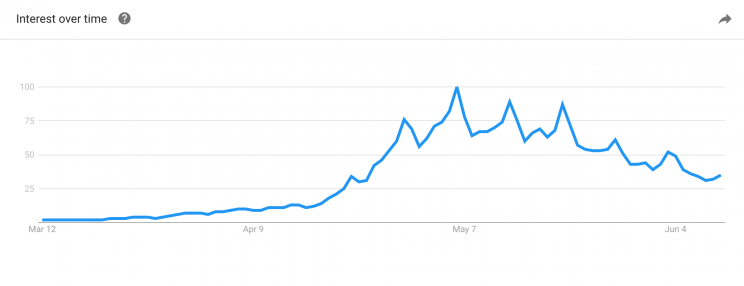These two charts show the meteoric rise—and fall—of fidget spinners

Fads are one of the more bizarre parts of the consumer economy. They are fickle and hard to predict, usually only happening thanks to a perfect storm of infinite factors. The latest fad is the fidget spinner, a handheld ball-bearing enabled device designed to release nervous energy.
Today, data from technology platforms provide some insight into fads like this and how they can take off.
Square (SQ) provides a payment services platform for many small retailers, handling around $14 billion in transactions per quarter. It’s enough to get a sense for how these products go viral.
The company analyzed the number of fidget spinners sold per month. In January and February, the number sold across the company’s platform was only 33 and 34, respectively.
In March, fidget spinners flickered up to 859, a change of 2,426% before jumping up to 26,223 in April. By the end of May, a whopping 151,241 had been sold via the platform. From the data, you can see how the fidget spinners took off with massive exponential growth.

As a fad, the fidget spinner may have the life of a bug, living and dying in a spectacular but brief fashion. Early June data shows that already the sales have dropped off—in the first 11 days only 39,339 spinners sold. Another available metric, Google searches, confirms that the fidget spinner is already passé.
According to Google, fidget spinner interest exploded in the last 10 days of April and then began experiencing surges on Saturdays, with the first Saturday in May being the high-water mark for fidget spinners.

Square noted that Saturday was the most popular day for people to buy these spinners, and that Missouri merchants sold the most spinners, beating out the other top five states of Georgia, Texas, California and New Jersey.
Already, however, the spinners’ momentum has slowed down in terms of Google interest. As Wharton professor and fad researcher Jonah Berger told NYMag.com, “The faster they catch on the faster they die out. I’ll be surprised if we’re still talking about them in six months.”
And so, while fidget spinners may have good ball bearings, they don’t spin forever.
Ethan Wolff-Mann is a writer at Yahoo Finance focusing on consumer issues, tech, and personal finance. Follow him on Twitter @ewolffmann. Got a tip? Send it to [email protected].
Read more:
How CEOs reacted to Trump’s withdrawal from the Paris agreement
Study shows how GOP plan would lower premiums: ditching costly, sick people
How the Obamacare repeal could affect your employer insurance
The biggest problem with robots taking jobs may not be unemployment—yet
What Facebook and Twitter think they know about you
Online savings accounts are raising rates. Big banks aren’t.